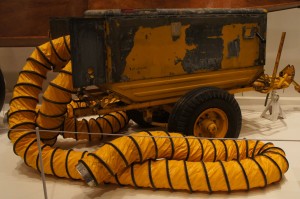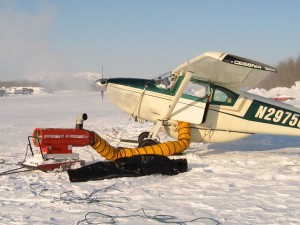 Early Alaskan pilots fought to conquer the air over America’s last frontier. The pilots were daring, adventurous, innovative individuals who became known as bush pilots. They delivered mail and freight and carried passengers to remote rural places in a remarkably short time but not without risks.
Early Alaskan pilots fought to conquer the air over America’s last frontier. The pilots were daring, adventurous, innovative individuals who became known as bush pilots. They delivered mail and freight and carried passengers to remote rural places in a remarkably short time but not without risks.
Today the Iditarod Air Force, a team of dedicated bush pilots who donate their time, talents and ski equipped bush planes to support the mushers on the Iditarod Trail running to Nome. They transport goods, people and dogs up and down and along the trail. They play a vital role in making The Last Great Race happen.
 Arctic Flight – Century of Alaska Aviation is a display at the Anchorage Museum celebrating the 100th anniversary of flight in Alaska. The centerpiece of the exhibit is a 1920s Stearman C2B biplane. There were numerous other early aviation artifacts on display including landing skies, landing floats, survival supplies, clothing and a heater. When it’s cold, really cold, pilots don’t just park their planes in the evening and than jump in, start up the engine and take off the next morning. With a machine, it just doesn’t work to go from cold inactivity to hot operation. Heaters such as this Herman Nelson BT400 Portable Aircraft Heater pump heat into the plane thereby avoiding destruction of the aircraft engine and body. The model on display was used in the 1950’s. The heater in the second picture is pumping heated air into Iditarod Air Force pilot, Danny Davidson’s plane on a morning in McGrath during the race when it was 30 degrees below zero. There is also an engine heater on Danny’s plane that’s plugged in over night to keep the oil and other lubricants warm.
Arctic Flight – Century of Alaska Aviation is a display at the Anchorage Museum celebrating the 100th anniversary of flight in Alaska. The centerpiece of the exhibit is a 1920s Stearman C2B biplane. There were numerous other early aviation artifacts on display including landing skies, landing floats, survival supplies, clothing and a heater. When it’s cold, really cold, pilots don’t just park their planes in the evening and than jump in, start up the engine and take off the next morning. With a machine, it just doesn’t work to go from cold inactivity to hot operation. Heaters such as this Herman Nelson BT400 Portable Aircraft Heater pump heat into the plane thereby avoiding destruction of the aircraft engine and body. The model on display was used in the 1950’s. The heater in the second picture is pumping heated air into Iditarod Air Force pilot, Danny Davidson’s plane on a morning in McGrath during the race when it was 30 degrees below zero. There is also an engine heater on Danny’s plane that’s plugged in over night to keep the oil and other lubricants warm.


